I have been writing about studying abroad and some tips about the U.S., but I also want to write about my great hobby, taking a trip, as I mentioned in the first blog. By the beginning of the spring semester at the end of January, probably I will have a lot of free time, hence I think I can write about the trip, too.
influence by my family
I know there are some students who start to visit many places after entering university.
However, at the same time, it is also true that some do not have any interest in taking a trip.
Out of the university students, I think I am a big lover of taking a trip, and thankfully some of my friends think so, too.
Then, the reason why I really like to take a trip is the influence by my family.
My parents made a plan to visit all the 47 prefectures in Japan when I was born even though I do not know why.
Honestly, I do not have a memory of prefectures that I visited before entering elementary school, but we achieved that goal when we visited Tokushima and Kagawa prefecture when I was a 3rd grade of junior high school.
Sightseeing in each prefecture is required to count as visiting that prefecture, but I have stayed overnight at all the prefectures but Chiba, Saitama, Tochigi, Ishikawa and Tokushima.
When I was a junior high school student, I hesitated to take a trip with my family, but I am grateful to them for letting me visit all the prefectures in Japan.
Another factor
I entered university thanks to the strong relationship between my high school and university, thus I did not take the entrance exam. This means that I had a very long winter and spring vacation after the end of the 2nd semester of the 3rd grade. At that time, the faculty of my university required me to read one English book during the vacation as an assignment.
I chose a book “Hiroshima”, which is on the atomic bomb that was dropped at Hiroshima on August 6th, 1945 and the real experience of people in Hiroshima on that day. I learned the seriousness of the atomic bomb through the English resources for the first time in my life. This book described what some particular people did when it was dropped and how they spent their life after that horrible incident, thus it contained a lot of names of local areas in Hiroshima.
Since I had a free time for about three months, thus I was thinking of visiting some areas in Japan, but after reading this book, I really had a strong desire to visit Hiroshima. The last time I visited there was when I was a kindergarten student, thus I had almost no memory, thus I decided to go to Hiroshima by using a Seishun-18 ticket, which is a very cheap ticket that can only be used for local trains, not Shinkansen and express trains. It took about 15 hours to go to Hiroshima from Tokyo by local trains(for Shinkansen, it takes about 4 hours).
When I returned to Tokyo from Hiroshima, I visited many other prefectures such as Okayama, Hyogo, Osaka, Kyoto. It was a pleasure for me to visit many places and prefectures in one trip, thus I decided to again visit all the prefectures in Japan before graduating from university by myself.
Again, visiting all the 47 prefectures
Thus, the ‘trip’ is a domestic trip in Japan for me.
Of course, as I now study in the U.S., I am highly interested in visiting other countries.
However, there are over 190 countries in the world, and from many perspectives such as finance, safe, and sanitary condition, visiting all of them is almost impossible.
What is important in my policy is accomplishing 100%, thus I think it is a good goal to visit all the prefectures in Japan for 4 years (in my case, about three years because I stay in the U.S. for about 9 months) because it is possible to achieve that goal even though it’s not easy.
I am now in the U.S., thus before going back Japan next May or June, I can’t visit anywhere in Japan. Thus, I would like to show you how many prefectures I have already visited for about one year and a half in the next chapter.
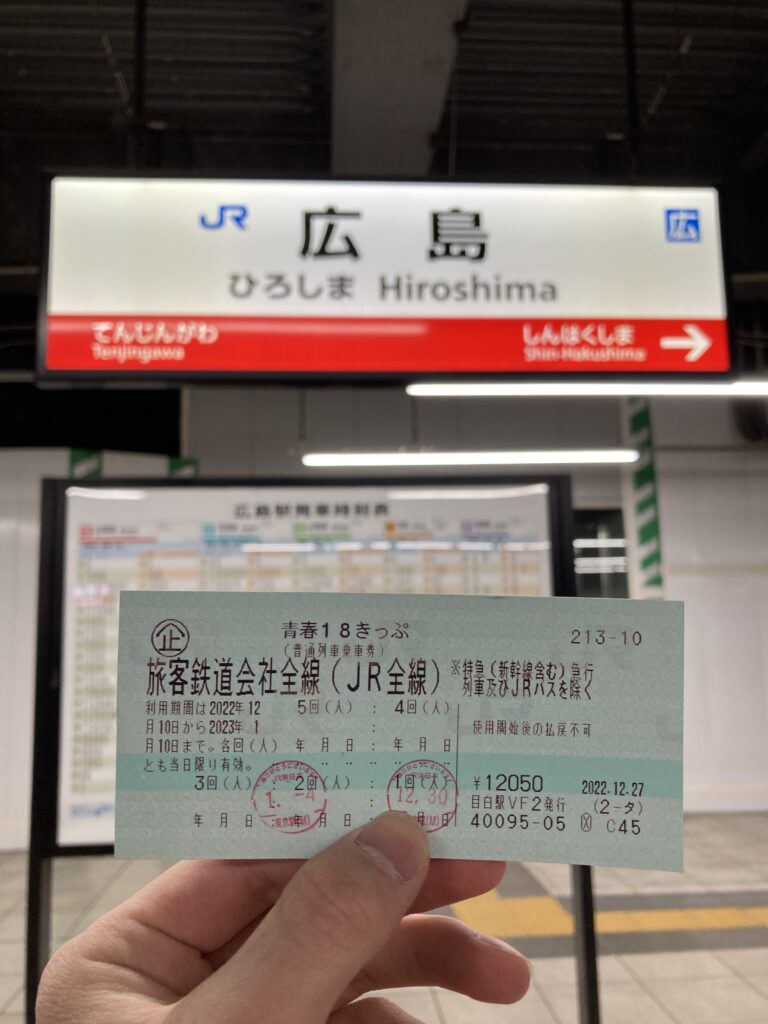
↑This is a picture of the Hiroshima Station with the Seishun-18 ticket. I took the train for 15 hours on that day, which is definitely the day that I took the train the most in my life.
My present progress information
Here, I would like to tell you how many prefectures I have visited before coming to the U.S.
Keiken-chi (the “prefecture” experience point)
There is an appropriate app and a website that is suitable for recording the prefectures.
It is called as “keiken-chi”, which counts the stay, visit and so on at each prefecture as a score.
By using the website version, you are precisely able to record the city, town, and village in each prefecture, but I use the IOS version.
(Even though it is a very great app, this app does not have an English translation. However, by checking the color and number as shown below, I think you can understand the system. If you have an interest, please download and use it!!)
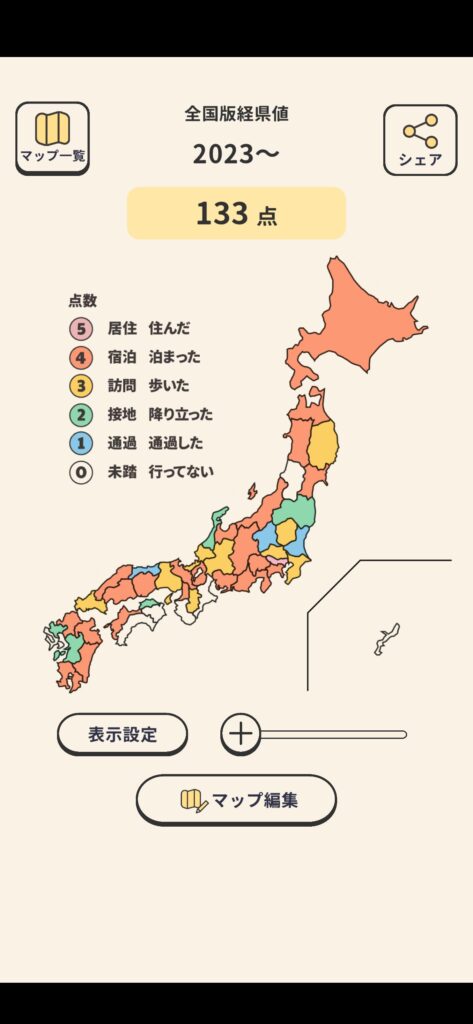
↑This is my “keiken-chi”, the “prefecture” experience point, now.
As is listed above, the score is counted from 0 to 5. My home is located in Tokyo, thus it is regarded as living and get 5 points. Once you stay at the hotel, it is staying and 4 points. Just sightseeing and not staying overnight is counted as visiting and 3 points.
The difference between 3 and 2 points is difficult because 2 points are touching, which means I have been to that prefecture only for transferring or taking a rest in a highway, and have not done sightseeing.
For me now, the prefectures that are counted as 2 points are Fukushima, Ishikawa, Kagawa, saga and Kumamoto, and how I touched these prefectures were of course different.
For these five prefectures, I have not been there other than “touching” since I became a university student, thus today, I sum up how I “touched” there.
I can get 1 point by passing the prefecture, which is even not touching but just passing when taking Shinkansen, trains, highway buses and so on.
For example, Tottori is regarded as passing because I passed Yonago, the second biggest city in Tottori, when I took the highway bus from Matsue, Shimane to Osaka.
Fukushima, Ishikawa, Kagawa, Saga, Kumamoto
Fukushima
First of all, I would like to write about Fukushima prefecture. The last time that I stayed in Fukushima is when I went to the British Hills, which is a British-style hotel located in the mountain area in Fukushima that also produced a lot of English educational programs when I was a 1st grade of junior high school.
As I wrote in the previous blog, I started to study English after I entered a junior high school, and it was the first time for me to get the opportunity to use English as an output. It was a three-day program.
All the facilities in this hotel are the British-style, and it is called as “The Britain anyone can visit without a passport” according to the official website.
At that time, it was just the first four months since I began studying English, thus I did not like English very much and do not remember a lot of memories. What I still remember is that the room in which I stayed was very dark due to the British-style and I could not sleep at all because I drank a lot of coffee at night.
This hotel is located in the mountain, and I took the shuttle bus from Shin-Shirakawa Station (Tohoku-Shinkansen and Tohoku-Line). I remember that the mountain path was really steep.
When I went there, the weather was pretty bad same as the U.K., thus I was not able to visit the beautiful lake near the hotel.
I was not able to enjoy this stay, but it was probably because I did not like English very much at that time. If I go there now, I can probably entertain it much better than I did.
Since I became a university student, I touched Fukushima prefecture at Shin-Shirakawa, Koriyama and Fukushima Station for transfer when I went to Sendai from Tokyo by local trains. I even did not exit the entrance of these stations, thus I did not visit any sightseeing spots.
I am especially interested in Aizu area, which is a west side of Fukushima prefecture and famous for Inawashiro-Ko Lake, Aizu-Wakamatsu, and Bandai-Atami. These areas are not very far from Tokyo, hence I would like to visit there after going back Japan.
Ishikawa
Ishikawa is a very popular destination not only for university students but also for tourists from other countries.
Places such as a magnificent station building of Kanazawa Station, Kenroku-En Park, Chaya-Gai District, and 21st Century Museum of Contemporary Art are famous for the Instagrammable spots, and Go! Go! Curry, a famous curry restaurant which are located not only in Japan but also in other countries and cities such as New York also derived from Kanazawa.
Also, there are a lot of sightseeing spots like Noto Peninsula (where experienced a severe earthquake on January 1st, but famous for unique view, a morning market and lacquerware and a baseball museum of Hideki Matsui, who played in New York Yankees from 2003 to 2009 and became the first Japanese player who won the World Series MVP in that prefecture, but I have never stayed there.
I went to Kanazawa with my parents just before graduating from elementary school, but that was a really busy trip because we went to Toyama, Ishikawa and Fukui. We stayed at the hotel in Toyama and Fukui, but did not in Ishikawa. I just visited Kenroku-En Park and transferred at Kanazawa Station, thus the length of time I was in Ishikawa may be the shortest of the 47.
Again, I went to Hokuriku region (Toyama, Ishikawa and Fukui prefecture) this spring as is showed in the map above.
It was just a few days prior to the operation of Hokuriku-Shinkansen between Kanazawa and Tsuruga (a station in Fukui prefecture), thus I used a discount ticket to go there. However, before this trip to this region, I went to Matsuyama, a city in the western part of Japan, and on the day I came back Tokyo from Matsuyama, other friends whom I went to Hokuriku together went to Kanazawa. Thus, I visited Hokuriku region one day later than them, and they had already enjoyed sightseeing in Kanazawa, thus I could not.
Same as seven years ago, I again transferred at Kanazawa from Shinkansen to Thunderbird, which was an express train that connected Kanazawa and Osaka before the open of the Shinkansen, in order to go to Fukui.
I have a plan to go to Hokuriku region again before graduating from university, thus I would like to visit many places in Ishikawa prefecture then.
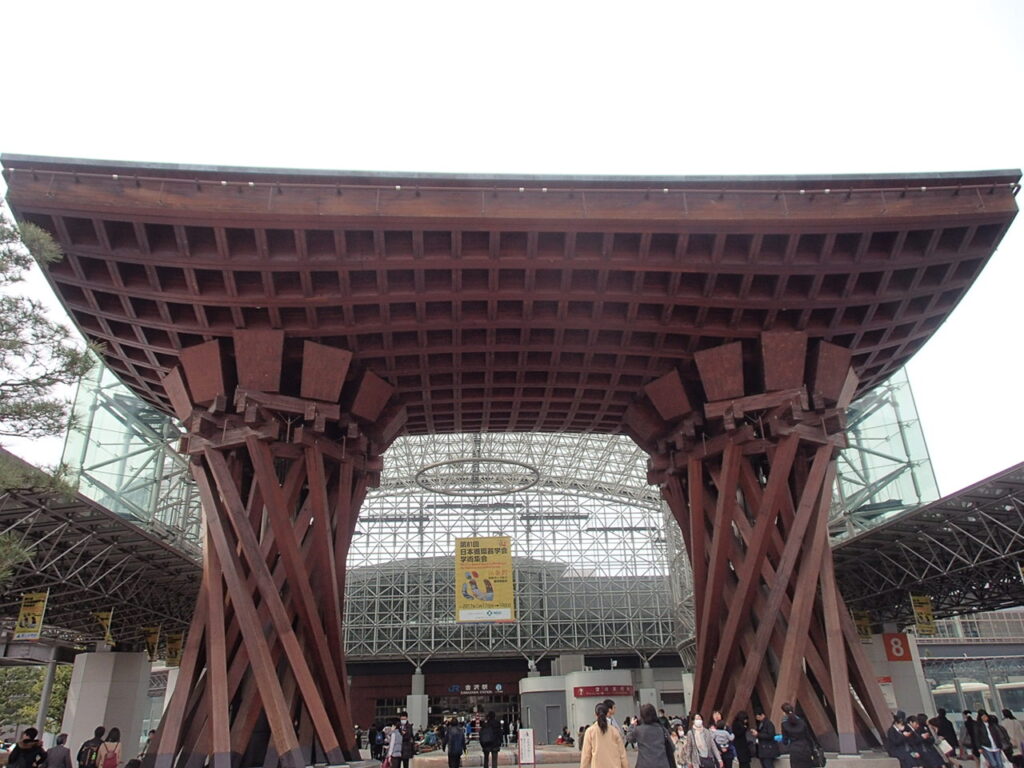
↑I took a picture of Kanazawa Station when I visited there for the first time in my life. Needless to say, this appearance is magnificent.
Kagawa
Kagawa is famous for the smallest prefecture in Japan in terms of size and udon, a Japanese noodle, and the final destination of our family’s goal to visit all the 47 prefectures was Kagawa.
At that time, I went to Kagawa from Kobe through two big bridges, Akashi-Kaikyo Bridge and Onaruto Bridge. I ate udon located in the Takamatsu-Chuo shopping district that was famous for the longest arcade in Japan and visited the Ritsurin Park.
Also apart from Takamatsu, I went to Yashima Observatory, which was famous for the Battle of Yashima. I will never forget the great view of Takamatsu City and Shodo-Shima Island from there.
However, at that time, we did not have a lot of time, thus just after staying at the hotel for one night, we immediately came back Kobe. Due to this busy schedule, I was not able to visit other famous sightseeing spots such as Marugame Castle, Kotohira Shrine and Chichibuga-hama Beach.
It is now counted as touching because I went there when I came back Tokyo from Hiroshima by local trains that I mentioned above. During that trip, I and my friend stayed at Okayama, and Takamatsu was only about one hour away from Okayama by rapid train “Marine Liner”, thus we went to Takamatsu only for the purpose of having a udon.
However, we did not have such a lot of time that we ate it at the udon restaurant in front of Takamatsu Station. I stayed there less than an hour and did not do sightseeing at all, thus I regarded it as touching.
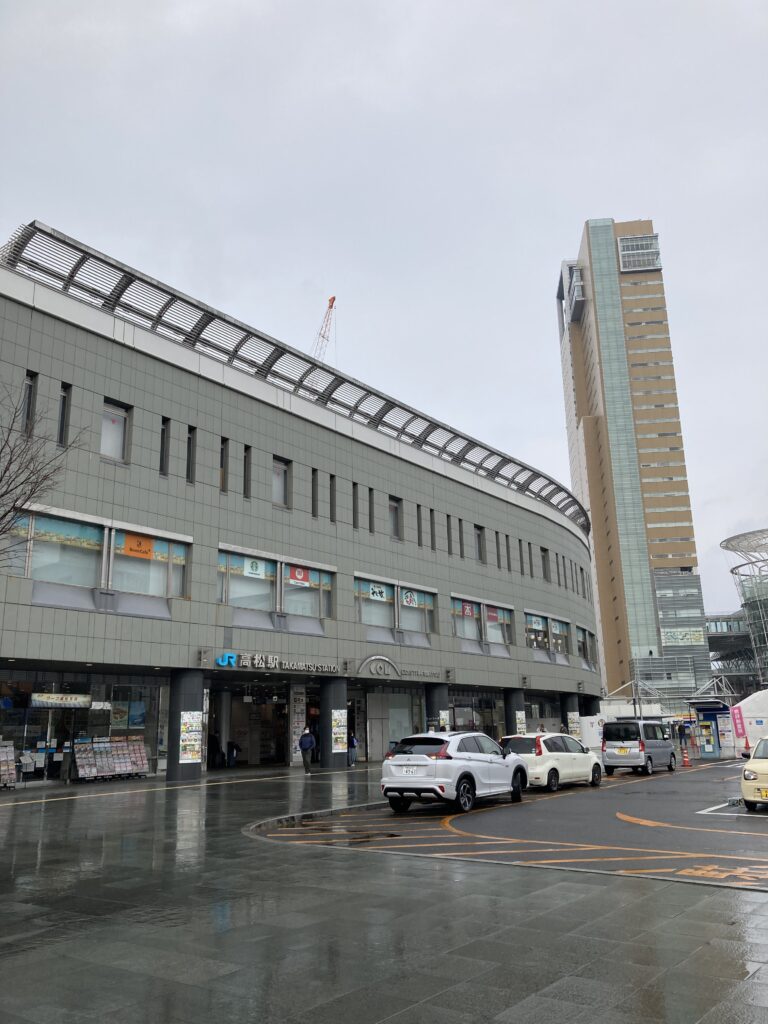
↑ If it was sunny, we were going to the Sunport Hall Takamatsu, which is a tall building in the right side, but we gave up because of the rain. The left building with a sign of light-blue color JR is Takamatsu Station.
Saga
I visited Saga prefecture when I was an elementary school student. At that time, we landed Nagasaki Airport, did sightseeing in Nagasaki city and then went to Huis Ten Bosch, which was a Dutch-style theme park in Nagasaki. After that, we visited Saga.
Specifically, I made a pottery in Arita by myself, which is famous for the Arita-yaki, a traditional ceramic ware. Then, we stayed at the Japanese traditional hotel “Chikurin-Tei”, located at Takeo-onsen hot spring.
Then, I did not know how luxurious this Japanese traditional hotel was, but it contained a big private open-air hot spring, which was impressive even for a child.
Saga is famous for ceramic ware not only in Arita but also in Imari and Karatsu, and Ureshino-onsen hot spring, which is also a popular hot spring are, is in this prefecture. Furthermore, Shigenobu Okuma, who is the founder of my home university, Waseda University and was the prime minister of Japan, was born in Saga, thus if I have a chance, I would like to visit Saga shrine, which has a unique root of him.
Since becoming a university student, I went to Hita, Oita with my family this summer, and during my drive from Fukuoka to Hita, I took a rest at Kiyama parking area, which is located near the border between Fukuoka and Saga.
I was sleepy while driving in the highway, thus I bought a cup of coffee at the convenience store. When you feel sleepy while driving, please take a rest!
Kumamoto
The last is Kumamoto, which is famous for the local mascot character, Kumamon.
I went to Aso, a volcanic area in Kumamoto just before the declaration of state of emergency.
What was surprising is that all the area of Mt. Aso ware black because of the field burning.
I visited a Shirakawa-suigen, which is a water source, and Nabegataki, a waterfall that was used for the television advertisement of Japanese green tea, Namacha (You have to make an online reservation in order to visit this waterfall now. Please be careful.).
I only used a rest room at Kita-Kumamoto service area when I went to Kagoshima from Fukuoka by taking Sakurajima, a highway bus. If I have a chance, I want to visit Amakusa Islands, which are the west part of Kumamoto.
In 2016, a big earthquake occurred in Kumamoto, and because of that, Kumamoto castle was destroyed. It has still been re-constructed, thus I hope it will complete as early as possible.
In addition to that, a delicious snack is sold in Kumamoto. That is a black sugar donut bar produced by Fujibambi. This is actually the last snack that I ate before coming to the U.S. because one of my friend gave it to me at Haneda Airport. If you have an interest, please try it once!
Tips about the name of Kumamoto
Kumamoto is written as “熊本” in Japanese, and this “熊” means bears in English. Furthermore, maybe you know, but the local character of Kumamoto is Kumamon, which is a bear mascot. However, what is interesting is that Kyushu Area including Kumamoto has been declared that the bears are extinct in 2012. Thus, no bears are living in Kumamoto.
In the past, actually another kanji “隈本”, a Japanese character, was used for Kumamoto, but it was renamed as “熊本”, which is the current one, in 1607 when Kumamoto castle was completed by Kiyomasa Kato, a Japanese warrior.
It has been said that he changed the kanji from “隈” to “熊” because the character “隈” seemed to be weak because “畏”, the right part of “隈” contained a negative meaning and that was not suitable for the castle, which was a place to protect the boss from the opponent in the past. Of course, “熊” is very strong because it is a bear.
(reference: https://gogen-yurai.jp/kumamoto-ken/)
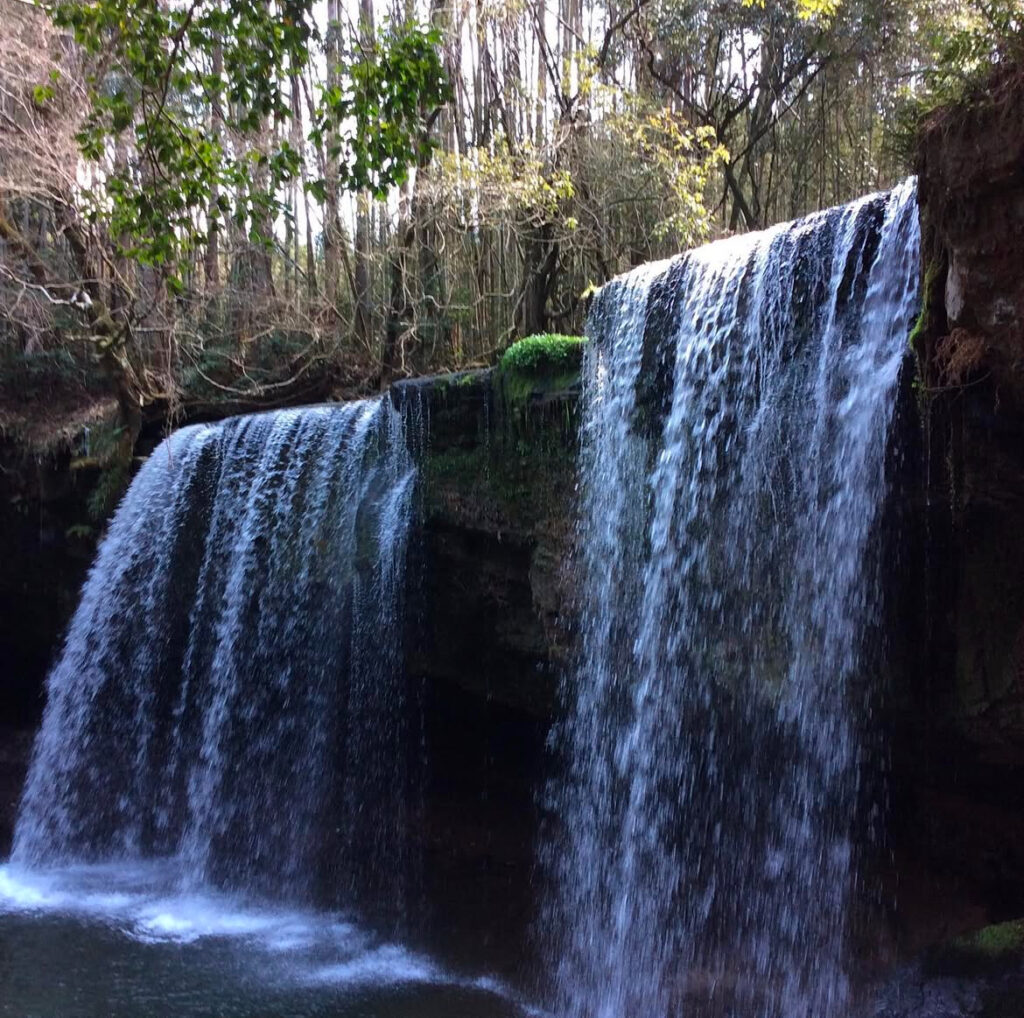
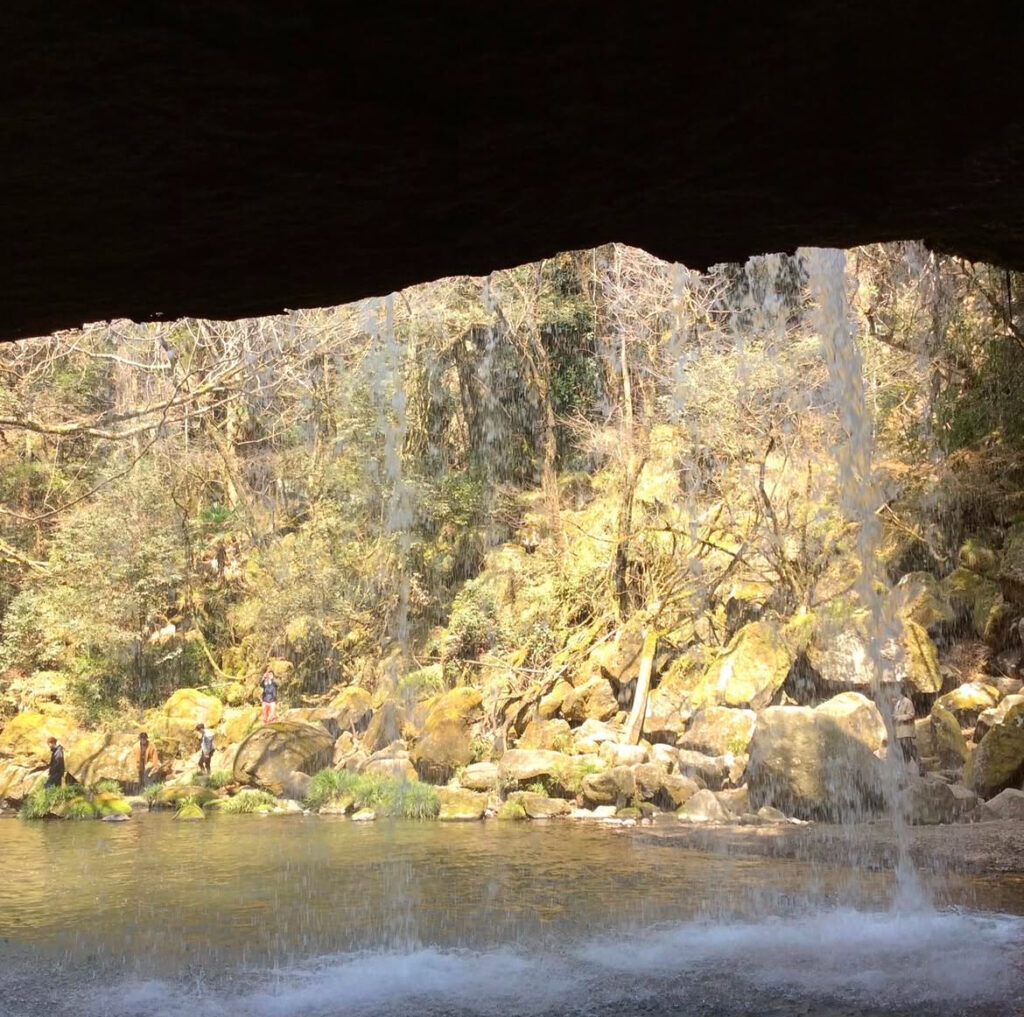
↑This is the picture of Nabegataki waterfall. The first picture is the one taken from front and the second is from back. Please be careful of a snake.
Problems
Even though I have made a decision to visit all the 47 prefectures in Japan, it is true that I have been driven a desire to visit the same places again.
However, in this app “keikenchi”, once I stayed at the prefecture, I can get four points and that score does not change even if I stay for a long time.
For example, I went to Kagoshima in the spring vacation last year before becoming a university student, and I really love to visit Kagoshima since then. After becoming a university student, I went to Kagoshima four times.
Also, I like to watch a professional baseball game, thus I have been to some cities such as Sendai, Osaka and Fukuoka for that several times.
If I had limited to go to the same place more than once, I might have achieved the goal even before going to the U.S., but I have never regretted about visiting there many times, and after going back Japan, I would go there again.
According to the map above, I have never even passed Yamagata, Mie, Wakayama, Tokushima, Kochi, Nagasaki, and Okinawa, hence I will make a plan to visit there.
What is important for me when taking a trip
Among the travel lover, each of them has different points that they want to emphasize.
For example, some want to stay at the luxury hotel and relax, or some choose to stay at the cheap hotel but prioritize visiting many places.
I am a university student, thus I try to save money and stay at the cheap hotel. I sometimes even stay at the capsule hotel. However, I have one point that I really emphasize on.
That is, to use public transportation as many as possible.
I visit many cities or areas from all over Japan, thus in some of them the train comes every two hours or I have to walk a lot from the station to go to the destination.
In that case, renting a car and visiting these destinations must be the most comfortable, but that means I do not need to make a precise schedule, which is against my policy.
As a travel lover, I would like to check the map and the time schedule of the train and the bus and make a plan based on it. By doing so, I can visit most of the sightseeing spots.
It can definitely make me feel attainable and it is a lot of fun for me to go to the destination by taking the JR lines and local buses.
For example, in Kagoshima, Nishi-Oyama Station, which is the southernmost JR station, is of course the train station, but only 7 or 8 trains stop at it, thus many of them use cars instead of trains. I’ve been there twice, and I used JR Ibusuki-Makurazaki Line both time. Also, Kirishima-Jingu Shrine is a very popular destination, but it is very far from the station, thus we need to take the bus from the closest station. When I went there, I precisely checked the schedule and visited there by taking the JR express Kirishima and Kagoshima-Kotsu bus.
If you do not hesitate to search these information, I hope you use public transportation when you take a trip, which result in the financial support for these local JR lines and buses that are struggled with financial problems these days.
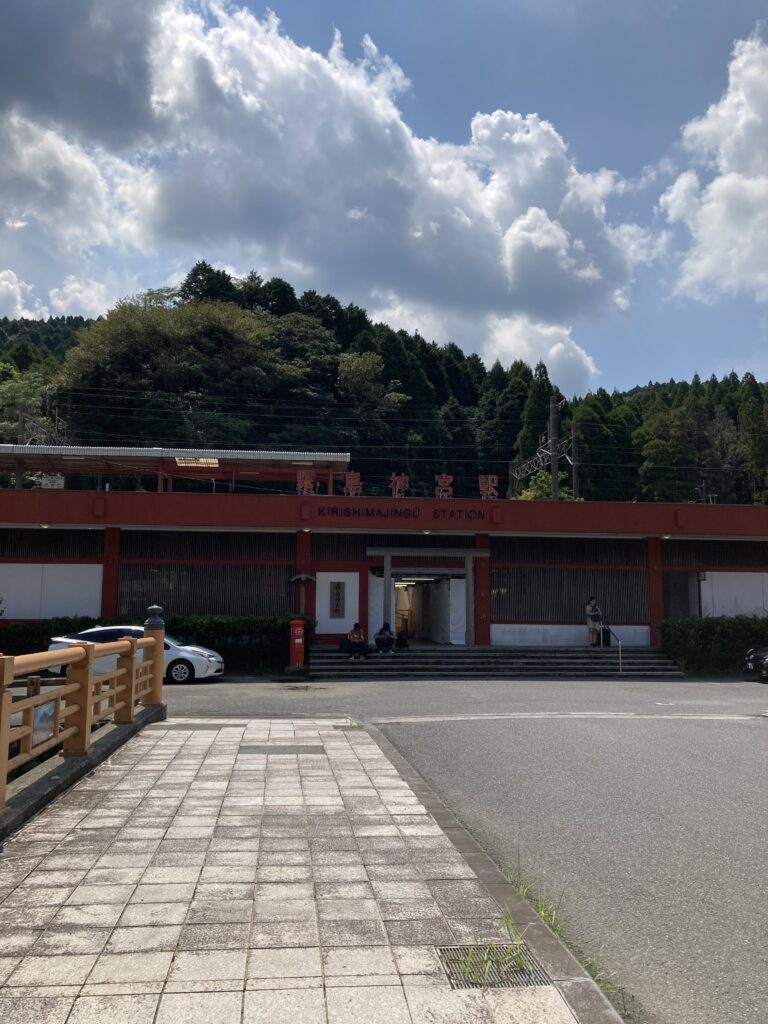
↑This is the picture of Kirishima Jingu Station, which is the closest station of Kirishima-Jingu Shrine. This station building looks like the shrine thanks to the red color. It takes about fifteen minutes to go there by bus.
It was a long blog today, but thank you very much for reading.


Comments